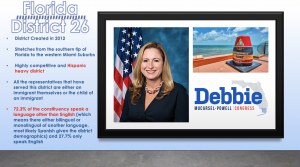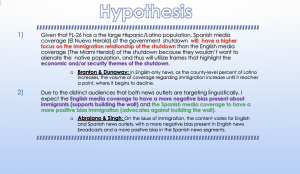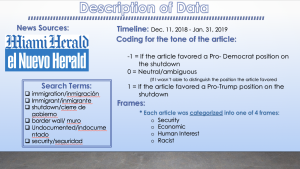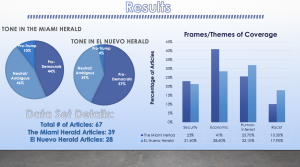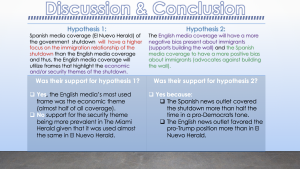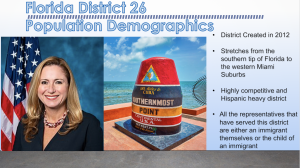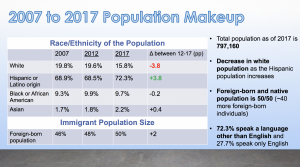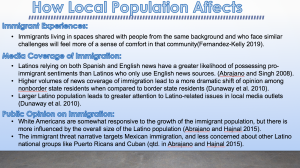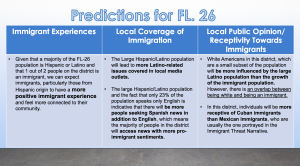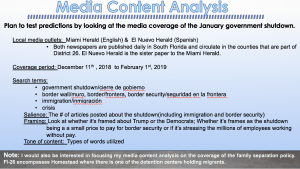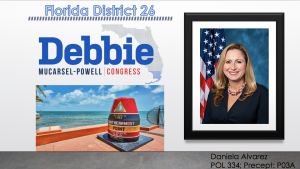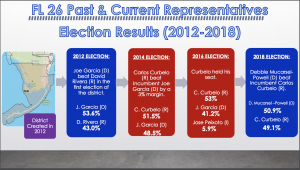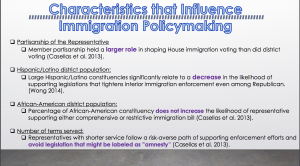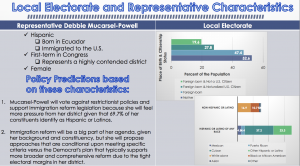Summary:
Do you remember when Debbie-Mucarsel Powell unseated the two-term Republican incumbent in Florida House District 26’s highly contested election? Yeah, I do too, and I’ve spent a semester looking at how some critical features of the district like demographics and partisanships’ influence immigration policymaking in FL-26. These demographics along with existing literature on immigration provide some context as to how Representative Mucarsel-Powell can adequately perform the job she was elected to do—be an advocate for all her constituents at the national level—and still be reelected come 2020. Important characteristics of the district like it’s large Hispanic/Latino population, 50/50 split between the native and foreign-born population and lack of party strength help predict in what ways and to what extent Representative Mucarsel-Powell, the first South American immigrant elected to Congress, will be responsive when it comes to immigration. Since taking office earlier this year, so far, she has demonstrated that she will be a strong and powerful voice that is willing to push back against legislation that disfavors her constituents. Although representative Mucarsel-Powell has not had the chance to vote directly on an immigration bill, we can look at her active advocacy for the Venezuelan community and resistance to family separation and the detainment of migrant children as a proxy for what her legislative plan for immigration will be. After presenting, my claims supported by existing research, I suggest that she continues to be a powerful voice in the immigration dialogue, vote for immigration reform when the chance comes, and keep calling out and acting against the hateful rhetoric and policies that target and dehumanize immigrants, particularly Latino immigrants.
Op-ed:
Don’t Stop, Don’t Give In: Why Congresswoman Debbie Mucarsel-Powell Must Continue to be a Vocal Voice on Immigration Policymaking.
When I think about South Florida—the place that welcomed me 16 years ago and I’m lucky to call home—my mind instantly pictures the immigrant communities, particularly from the Carribean and Latin America, that serve as the backbone of the region. Culturally, at times it feels more like we’re living in the Caribbean or Latin American than in the U.S. because immigrants play an integral part of the broader South Florida community and have created neighborhoods like Little Havana. Politically, Latinos and Hispanics comprise a significant share of the electorate, and in Florida politics, their vote can determine the outcome in highly contended races.
Talking about highly contended congressional races, remember when Debbie-Mucarsel Powell unseated the two-term Republican incumbent in Florida House District 26? Yeah, I do too, and I’ve spent an entire semester looking at how some critical features of the district like demographics and partisanships’ influence immigration policymaking. This helps consider how Representative Mucarsel-Powell can adequately perform the job she was elected to do—be an advocate for all her constituents at the national level—and still be reelected come 2020.
Before we get into specific policy predictions, let’s get a glimpse of who Mucarsel-Powell is representing. FL-26 is a Hispanic dense district, with 72.3% of the 2017 population identifying of Hispanic or Latino origin, 15.8% white, 9.7% Black or African American and 2.2% Asian. Within the Hispanic community, the majority of the district Hispanics are either Cuban or from another Hispanic background, which I presume to be mostly from Central and South American countries such as Colombia, Venezuela, and El Salvador. In the past five years, there has been a slight 3.8% decrease in the white population, and an equaled 3.8 increase in the Hispanic population. It is essential to consider not only the size and growth of the Hispanic population but also the make-up of it as it relates to the effects it has on public opinion amongst whites, which can pressure the representative to vote in a certain way.
According to Abrajano and Hajnal, white Americans are somewhat responsive to the growth of the immigrant population, but they’re more influenced by the overall size of the Latino population. This signals, that because of the large population, white Americans in FL-26 might favor more restrictive policies on immigration. However, Abrajano and Hajnal cited research that finds that the immigrant threat narrative targets Mexican immigration, and is less concerned about other Latino national groups like Puerto Ricans and Cubans, which there are far more of in the district.
That’s one layer of the demographics in the district, but we can get even more insight by looking at the foreign-born and native population. Currently, the district is evenly split (50/50) with about 40 more foreign-born individuals than native-born, and about 94% of the foreign-born population coming from Latin America. Another critical split to consider is partisanship; in this district, of party-affiliated voters, half are Republicans and the other half are Democrats. There is no denying that FL-26 is a battleground district, and that brings forth important electoral considerations for any representative of the district.
Other important components are that 58% of the foreign-born population are naturalized citizens, and 72.3% of the people in the district speak a language other than English (which means there either bilingual or monolingual of another language, most likely Spanish given the district demographics) and 27.7% only speak English. This explains why so many of Representative Mucarsel-Powell’s tweets and interviews are in Spanish and is another indicator of her responsiveness and inclusiveness of the Hispanic/Latino population.
All of these important characteristics help predict in what ways and to what extent Representative Mucarsel-Powell, the first South American immigrant elected to Congress, will be responsive when it comes to immigration. Since taking office earlier this year, so far, she has demonstrated that she will be a strong and powerful voice that is willing to push back against legislation that disfavors her constituents. Although representative Mucarsel-Powell has not had the chance to vote directly on an immigration bill, we can look at her active advocacy for the Venezuelan community and resistance to family separation and the detainment of migrant children as a proxy for what her legislative plan for immigration will be.
Tom Wong’s 2017 research shows how immigrants play a determinative role in shaping policy outcomes by shifting median voter preferences away from policy restrictiveness. This provides a lense as to how Representative Mucarsel-Powell might face some challenges as she attempts to balance some of the splits in her districts’ demographics. Wong’s theory assumes that representatives are going to play the median voter strategy to capture the median voter and win re-election. On her campaign website, Mucarsel-Powell lists her policy proposals on immigration, and we can see that they are very targeted at the immigrant communities present in her district. She’s in favor of immigration reform, but we can see how she differs from the Democrats, that typically supports a more comprehensive and broader immigration agenda. She does not want to establish a comprehensive path to citizenship, at least not explicitly; what she wants is to create a path to citizenship for DREAMers. Her current policy proposal seems very conditional and will apply only to immigrants that fall within specific categories, and this seems like her way of balancing the dynamics in her district. However, I think her ability to unseat Curbelo, and the upward trend in the foreign population, which Wong claims will move the location of the median voter, gives her opportunity down the line—if she holds on to her seat—to advance even more liberal legislation on immigration that supports immigrants in more ways.
Now turning to Casellas and Leal’s 2013 research. Here, they examined the interaction of partisanship, constituencies, and member characteristics on the member of Congress’ voting behavior on immigration. They concluded that partisanship is the only consistent factor and that district demographics and the personal attributes of the member of Congress were not consistently associated with votes. Mucarsel-Powell seems to be the antithesis to this, she ran on a platform that highlights that she’s an immigrant and since taking office, has used her connection to Latin America to take a firm stance against Trump’s hateful and criminalizing rhetoric against immigrants from that region. One of the few bills that she’s sponsored, which passed, gave humanitarian assistance to Venezuelans both inside and outside the country. Of the 300,00 Venezuelans living in the U.S., 200,000 live in South Florida, so it’s not surprising that a coalition of Democratic congresswoman from South Florida have pushed for Venezuelans to be granted temporary protected status and cease the deportation of non-criminal migrants, which is the most humane thing to do given the crisis in Venezuela.
The real test for Debbie-Mucarsel Powell will come when immigration-related issues aren’t at the forefront of the national agenda, which I quite frankly don’t believe will ever happen under the current administration, but that will show if she’s genuine about being an advocate and supporter of this community or if she’s doing it just because it might be political suicide back home if she doesn’t. I find myself believing that she’s honest in her intentions to help immigrants and that FL-26 is lucky to have her as their representative. I suggest that she continues to be a powerful voice in the immigration dialogue, vote for immigration reform when the chance comes, and keep calling out and acting against the hateful rhetoric and policies that target and dehumanize immigrants, particularly Latino immigrants.
I pledge your honor that this paper represents my own work in accordance with university regulations.
-Daniela Alvarez
